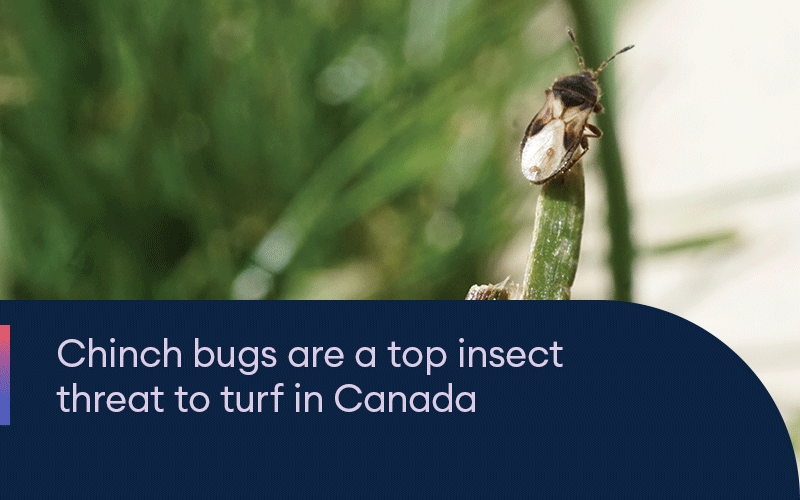Chinch bugs have gained a foothold as a top insect threat to turf in Canada
Chinch bug populations are increasing and so is the damage they cause to lawns and golf courses.

Chinch bugs were first identified in Ontario in 1971. Since then, the population of this destructive pest has been steadily increasing across Eastern Canada. Although chinch bugs are increasingly prevalent, golf course superintendents and homeowners don’t always attribute the brown, irregularly shaped, sunken patches to chinch bug damage.
In recent years, especially hot, dry summers, chinch bug has rivaled Japanese beetles, European chafers, and other white grub beetles as a top insect pest on golf courses and in home lawns.
Chinch bug sucks sap from turfgrass plants
Chinch bugs (Blissus species) are very small insects that overwinter in the turfgrass thatch and leaf litter and can feed on most cool season turfgrasses. They use their piercing mouth parts to suck the sap from the crown and stems of turfgrass plants.
As temperatures warm in the spring, the adults will mate and lay eggs in the turfgrass thatch or directly into the leaf sheaths of the turfgrass plant. When temperatures are below 20°C, it may take 20-30 days for the eggs to hatch. However, if daytime temperatures consistently exceed 25°C these eggs can hatch in just one week.
Early instar nymphs go through several stages before reaching adulthood. However, every stage of the nymph can damage plants through their piercing-sucking mouthparts. During feeding, nymphs and adults secrete a solution into the turfgrass plant that clogs the vascular tissues. This causes further stress as the secretion helps block the transport of water.
Populations can increase quickly
The average female adult chinch bug can lay up to 200 eggs. This results in skyrocketing populations of adults and nymphs during hot and dry weather in early summer. Nymphs can feed on turf for up to 6 weeks before seeking an overwintering site or reproducing a second generation. As few as 80 chinch bugs per square meter can cause visible damage in residential lawns.
Populations build within the rough and green surrounds – areas that aren't mowed as closely or regularly treated with insecticides – until they migrate to other turf. There can be a daily migration of thousands of chinch bug adults and nymphs moving from nontreated areas into treated areas. Once the concentration of the insecticide wears off, these migrating chinch bugs can move into the treated area and begin to cause further damage and decline.
Use growing degree days to gauge when to scout
Scout chinch bugs when they reach the 1st instar nymphs stage. The timing of this development stage depends on the number of growing degree days.
- Use a common base temperature of 7°C:
- Peak egg development at 187-340 GDD
- 1st instar nymphs observed at 250-500 GDD
- Peak damage period is 3-4th instar 500-1000 GDD (usually early to mid-July)
Scouting for chinch bug
The best way to scout for chinch bug is the modified flush method. Cut the bottom out of a coffee can and push it 2 inches into the ground. Fill the can with water and keep it filled for 30 seconds. Watch to see what floats to the surface.
Chinch bug nymphs are small and bright red in colour when they first hatch. They darken as they mature until they turn grey/brown in colour. Immature nymphs have a white band across their abdomen which is covered by the wings as the insect matures.
Cultural and chemical control
You can help your turf battle chinch bugs by utilizing strategies that keep it healthy:
- Irrigation. Where possible, irrigate to provide supplemental water during drought stress. This promotes a healthier turfgrass stand that can better tolerate chinch bug activity.
- Fertilization. Maintaining adequate nitrogen fertilization helps provide energy to the plant to help withstand chinch bug activity and to promote recovery during stressful environmental conditions. Be careful not to over-fertilize as this can also attract more chinch bugs and encourage their development.
- Plant genetics. Overseeding more resistant cultivars or species into the mix can help mitigate the damage of chinch bugs.
Chemical control is a critical piece to managing chinch bug. Chinch bug populations can increase exponentially during hot and dry weather. In a hot, dry summer it's not uncommon to see 600+ chinch bugs or more per square meter. This means it can be challenging to eliminate all visible damage, even when you are reducing the populations by 90% or more through chemical treatment such as Tetrino™ and Suspend PolyZone®.
Tetrino™ is a broad-spectrum systemic insecticide uses the active ingredient tetranililprole for rapid plant uptake and translocation with excellent residual efficacy.
It provides strong systemic activity for many root- and surface-feeding insects – including chinch bugs. Tetrino™ works best when the plant is actively growing. Repeat applications at 28-day intervals may be necessary for large chinch bug populations.
Suspend PolyZone® is a highly effective, fast-acting contact insecticide that can be used at low rates to control chinch bugs, ants, cutworms, webworms and ticks. Suspend PolyZone® contains the active ingredient deltamethrin, which is a third-generation pyrethroid insecticide. It should be applied in enough water volume to achieve deeper coverage into the turfgrass canopy.
For more information about Chinch Bug Management, download the Solution Sheet or contact your local Territory Sales Manager for insect control strategies specific to your needs.
ALWAYS READ AND FOLLOW PESTICIDE LABEL DIRECTIONS. Envu, the Envu logo, Tetrino® and Suspend PolyZone® are trademarks owned by Environmental Science U.S. LLC. or one of its affiliates. ©2023 Environmental Science U.S. LLC. All rights reserved.
